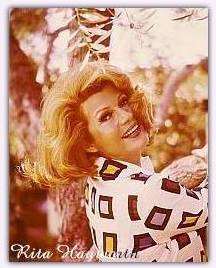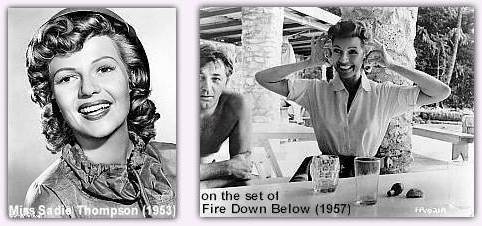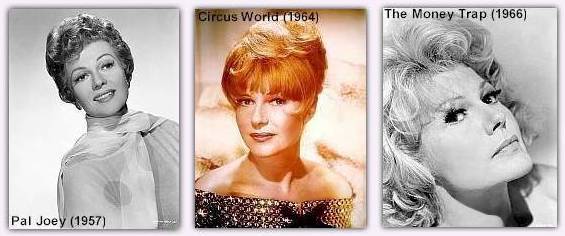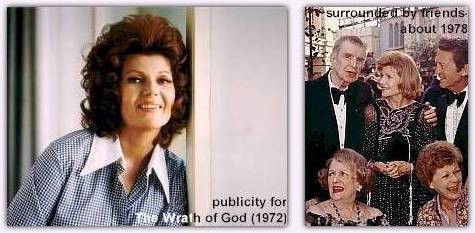

|
Before production began in Hawaii on her next picture, Miss Sadie Thompson, Rita began dating actor/singer Dick Haymes. They were married in Las Vegas on September 24, 1953. Unfortunately, though she remained off the screen for a few of years, Rita would face many unpleasant obstacles during her marriage to Dick Haymes that kept her in the headlines, and the target of bad publicity. Numerous court battles were to be fought during this time, stemming from Haymes' problems with the immigration department, the IRS and his ex-wives, among other things, making this a very difficult period in Rita's life, to say the least. She was granted a divorce from Haymes in December of 1955.
Rita took a much-needed break after her disastrous marriage to Haymes. She stayed in Europe for a while, but again had to returned to Hollywood. She was still under contract to Columbia Pictures. In 1956 she went back to work to begin production on Fire Down Below. Shot mostly on location in Trinidad, it starred Rita opposite Jack Lemmon and Robert Mitchum, and was directed by Robert Parrish. The camaraderie that developed between the four of them made the location filming a happy experience for Rita.

She had one more film to make for Columbia to fulfill her contractual obligations to the studio, Pal Joey. She was starred opposite Frank Sinatra and the woman Columbia was building up as Rita's "replacement", Kim Novak. If you watch the movie, you'll see that at thirty-eight Rita still looks and dances great. She shines in the film, particularly in the "Bewitched, Bothered and Bewildered" number. Nevertheless, Pal Joey turned out to be Rita's last musical. After that she left the studio that had been her home for twenty years.
Shortly afterward, Rita made They Came to Cordura, and The Story on Page One, which was released in 1960. Her next film, The Happy Thieves, was produced by she and her husband's newly formed production company, Hillworth. At this point in her life, Rita wanted to retire from films. When she married Hill, she would have been content to spend the her life with him writing and her painting. She loved to paint. But Hill had other ideas. He wanted her to continue working. He saw great potential in her as a comedic actress and wanted her to pursue this. She made They Came to Cordura so that they could buy a house, then The Story on Page One, and then she agreed to do The Happy Thieves to please her husband. He thought it would be a great vehicle for her to display her flare for comedy. Unfortunately, The Happy Thieves turned out to be a disappointment and shortly after, in late 1961, Rita's last marriage ended in divorce.

Rita then moved to Europe for a while. Back in America in 1962, she was slated to appear in a Broadway comedy called Step on a Crack starring her then boyfriend, Gary Merrill, but after a few weeks of rehearsal, she dropped out of the show. In Europe again in 1964, Rita made Circus World with John Wayne and Claudia Cardinale. Then in 1966 she was in The Money Trap and The Poppy Is Also a Flower, the first of which reunited her with her favorite co-star and close friend, Glenn Ford for their final film together. In the following years, Rita did a few European films, The Rover (L'Avventuriero), Sons of Satan (I Bastardi) and The Road to Salina (Sur la route de Salina), that had limited theatrical release in the United States. She also made television appearances, including a hilarious guest spot on a 1971 episode of The Carol Burnett Show.

In Rita's final years, none of her glamorous past or the heartache she had endured were even a distant memory in her mind. On Thursday, May 14, 1987 Rita Hayworth died peacefully in her daughter's apartment in Manhattan. Since then she has become a symbol of eternal youth, beauty and glamour. Her legend lives on thanks to the impact she continues to have on fans throughout the world. Her dream may have been a simple life with kids and a husband to spend the rest of her life with, but it was not to be. A simple life was apparently never in the cards for Margarita. |